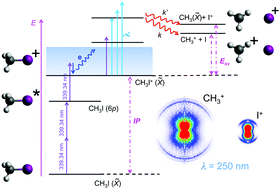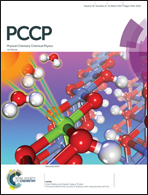A velocity map imaging study of the photodissociation of the methyl iodide cation
Abstract
The photodissociation dynamics of the methyl iodide cation has been studied using the velocity map imaging technique. A first laser pulse is used to ionize methyl iodide via a (2 + 1) REMPI scheme through the 5pπ → 6p Rydberg state two-photon transition. The produced CH3I+(![[X with combining tilde]](https://www.rsc.org/images/entities/i_char_0058_0303.gif) 2E3/2) ions are subsequently excited at several wavelengths between 242 and 260 nm. The reported translational energy distributions for the methyl and iodine ions present a Boltzmann-type unstructured distribution at low excitation energies as well as a recoiled narrow structure at higher excitation energies highlighting two different dissociation processes. High level ab initio calculations have been performed in order to obtain a deeper understanding of the photodissociation dynamics of the CH3I+ ion. Direct dissociation on a repulsive state from the manifold of states representing the
2E3/2) ions are subsequently excited at several wavelengths between 242 and 260 nm. The reported translational energy distributions for the methyl and iodine ions present a Boltzmann-type unstructured distribution at low excitation energies as well as a recoiled narrow structure at higher excitation energies highlighting two different dissociation processes. High level ab initio calculations have been performed in order to obtain a deeper understanding of the photodissociation dynamics of the CH3I+ ion. Direct dissociation on a repulsive state from the manifold of states representing the ![[B with combining tilde]](https://www.rsc.org/images/entities/i_char_0042_0303.gif) excited state leads to CH3+(
excited state leads to CH3+(![[X with combining tilde]](https://www.rsc.org/images/entities/i_char_0058_0303.gif) 1A1′) + I*(2P1/2), while the CH3 + I+(3P2) channel is populated through an avoided crossing outside the Franck–Condon region. In contrast, an indirect process involving the transfer of energy from highly excited electronic states to the ground state of the ion is responsible for the observed Boltzmann-type distributions.
1A1′) + I*(2P1/2), while the CH3 + I+(3P2) channel is populated through an avoided crossing outside the Franck–Condon region. In contrast, an indirect process involving the transfer of energy from highly excited electronic states to the ground state of the ion is responsible for the observed Boltzmann-type distributions.



 Please wait while we load your content...
Please wait while we load your content...